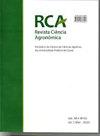非葫芦属植物对单孢子菌的反应。
IF 1
4区 农林科学
Q3 AGRICULTURE, MULTIDISCIPLINARY
引用次数: 0
摘要
本文章由计算机程序翻译,如有差异,请以英文原文为准。
Reaction of non-cucurbitacea to Monosporascus spp.
- With the recent discovery of five new species of the Monosporascus genus, a fungal genus involved in “ Monosporascus root rot and vine decline,” pathogenicity studies have become important to understand the impact of these new species on cultivated plants, mainly on plant species used as an alternative for crop rotation. This study aimed to evaluate the pathogenicity of Monosporascus spp. in non-cucurbitaceous cultures. The tests were carried out in duplicate in a greenhouse in a completely randomized design, with the treatments: One isolate of each species of Monosporascus ( M. brasiliensis , M. caatinguensis , M. cannonballus , M. mossoroensis , M. nordestinus, and M. semiaridus ) and the absolute control, and fi ve cultures (cowpea, jack bean, corn, sorghum, and bell pepper). Seeds of these cultures were sown in pots containing soil + Tropstrate HT ® (ratio 2:1, v / v), previously inoculated with wheat seeds colonized with the species of Monosporascus . After 50 days of sowing, plants were evaluated for incidence, disease severity, length of shoot and roots, fresh and dry weight of shoots and roots. All inoculated Monosporascus species were able to induce damage in cowpea and bell pepper cultures, with M. cannonballus being the most aggressive. Corn, jack beans, and sorghum presented few or no symptoms of the disease and may be indicated as alternative cultures to be used in crop rotation with cucurbits. Studies with a greater number of isolates and cultivars for each culture tested in this study should be carried out to strengthen the data obtained.
求助全文
通过发布文献求助,成功后即可免费获取论文全文。
去求助
来源期刊

Revista Ciencia Agronomica
Agricultural and Biological Sciences-Horticulture
CiteScore
2.00
自引率
0.00%
发文量
41
审稿时长
4-8 weeks
期刊介绍:
To publish technical-scientific articles and study cases (original projects) that are not submitted to other journals, involving new researches and technologies in fields related to Agrarian Sciences. Articles concerning routine analysis, preliminary studies, technical notes and those which merely report laboratorial analysis employing traditional methodology will not be accepted for publication. The Journal of Agronomical Science also has the mission to promote the exchange of experience in the referred fields.
 求助内容:
求助内容: 应助结果提醒方式:
应助结果提醒方式:


